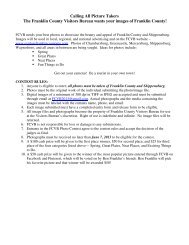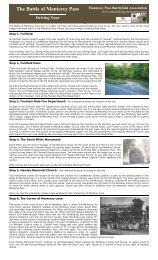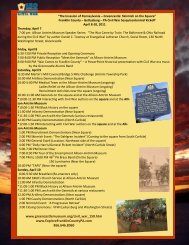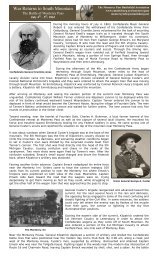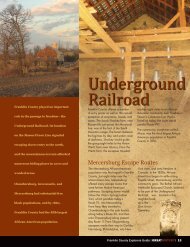Frontier & Forts Brochure - Explore Franklin County | PA
Frontier & Forts Brochure - Explore Franklin County | PA
Frontier & Forts Brochure - Explore Franklin County | PA
Create successful ePaper yourself
Turn your PDF publications into a flip-book with our unique Google optimized e-Paper software.
Benjamin <strong>Franklin</strong><br />
Who is that 8-ft. tall, 250 lb. golden figure in<br />
the window of the Chambersburg Heritage<br />
Center It is Benjamin <strong>Franklin</strong>. The one-of-a-kind<br />
likeness pays homage to the statesman, sage, and<br />
inventor that is the namesake of <strong>Franklin</strong> <strong>County</strong>.<br />
Ben spends his days looking over the visitors of<br />
the Chambersburg Heritage Center and his nights<br />
looking out across Courthouse Plaza in downtown<br />
Chambersburg.<br />
Rose Rent<br />
Churches of Chambersburg<br />
Religion was very important to all<br />
the settlers that came to <strong>Franklin</strong><br />
<strong>County</strong>. Benjamin Chambers – founder of<br />
Chambersburg – recognized the influential<br />
role religion played in the community, so<br />
he set aside three plots of land for three<br />
congregations in Chambersburg—Falling<br />
Spring Presbyterian, First Lutheran, and<br />
Zion Reformed. In return for the land,<br />
Chambers requested that each congregation<br />
would pay a yearly rent of one rose to a<br />
descendant of the Chambers Family. All<br />
three congregations continue today and<br />
honor the tradition of the rose rent. A<br />
mystery book, titled Death Pays The Rose<br />
Rent, was inspired by Chambersburg’s rose<br />
rent custom.<br />
A few facts about<br />
Ben <strong>Franklin</strong> & <strong>Franklin</strong> <strong>County</strong><br />
• Frederick Mayer of Pittsburgh carved the 1865 <strong>Franklin</strong> statue from<br />
pine before it was leafed in gold.<br />
• <strong>Franklin</strong> <strong>County</strong> was created out of Cumberland <strong>County</strong> by legislative<br />
action on September 9, 1784 and legislators decided on <strong>Franklin</strong> as<br />
the honoree.<br />
• <strong>Franklin</strong> is the third most popular county name.<br />
Do you know the two more popular names See the answer at<br />
www.<strong>Explore</strong><strong>Franklin</strong><strong>County</strong><strong>PA</strong>.com or 866.646.8060.<br />
• The 8-ft., 250-lb. gold-leafed Ben <strong>Franklin</strong> statue sat atop the <strong>Franklin</strong><br />
<strong>County</strong> Courthouse from 1865-1991. It was taken down and restored<br />
in 1991 by four local craftsmen. A fi berglass replica resides atop the<br />
courthouse today.<br />
8 │GREAT HISTORY│www.explorefranklincountypa.com
<strong>Frontier</strong> <strong>Forts</strong><br />
RIGHT VISITORS TO FRANKLIN<br />
COUNTY CAN SEE THE REPLICA<br />
FORT AND THE RESTORED PERIOD<br />
<strong>PA</strong>TTON HOUSE AND GARDENS,<br />
JUST OFF ROUTE 30.<br />
From 1730 to 1755, settlements along<br />
the <strong>Franklin</strong> <strong>County</strong> frontier sprang up.<br />
The influx of settlers pushed the Native<br />
Americans westward. Many Native<br />
Americans did not understand land ownership<br />
in the same way as Europeans, believing<br />
that the land belonged to the Great<br />
Spirit that they worshipped. Angered by<br />
the forced migration, Native Americans<br />
lashed out and attacked the settlers. In an<br />
effort to protect home and family, <strong>Franklin</strong><br />
<strong>County</strong> settlers built private forts around<br />
their frontier dwellings.<br />
Benjamin Chambers constructed a<br />
fort around his home, gristmill and<br />
sawmill, which were located near the<br />
Conococheague Creek and Falling Spring.<br />
Surrounded by water on three of its sides,<br />
Chambers Fort was 90-ft. wide and 300-ft.<br />
long and was defended by swivel cannons<br />
and blunderbusses. Other private forts<br />
of <strong>Franklin</strong> <strong>County</strong> were Fort Davis, Fort<br />
Maxwell, and Fort Marshall.<br />
Fort Loudoun was a British provincial fort<br />
that served as a supply and munitions<br />
center on the colonial frontier from 1756<br />
to 1765. The fort was a key supply depot<br />
of General John Forbes’ expedition to capture<br />
the French outpost at Fort Duquesne.<br />
Indian Attack s<br />
The fortifications settlers constructed<br />
as protection were not enough. In<br />
an effort to drive out and eliminate<br />
the settlers, Native Americans<br />
attacked <strong>Franklin</strong> <strong>County</strong><br />
frontiersmen. Delaware Indians<br />
attacked the private Fort McCord,<br />
near Edenville, on April 1, 1756.<br />
Twenty-seven pioneers were killed<br />
or taken captive. Several of the<br />
female captives were rescued five<br />
months later in a daring effort by<br />
frontier militia led by Col. John<br />
Armstrong. Today, a Celtic<br />
Cross marks the site of the<br />
attack of Fort McCord.<br />
Another fateful attack<br />
occurred on July 26,<br />
1764 at a schoolhouse<br />
near Greencastle, the<br />
Enoch Brown Massacre.<br />
Schoolmaster Enoch<br />
Brown pleaded for the<br />
lives of his students but was shot<br />
and scalped. Eleven children were<br />
tomahawked and scalped. One<br />
boy, Archie McCullough, was able<br />
to crawl to the nearby spring and<br />
survived the scalping. The warriors,<br />
who perpetrated the heinous<br />
massacre were rebuffed by their<br />
chief when showing the scalps of<br />
the young children. Brown and the<br />
students were buried in a common<br />
grave. Today a memorial stands<br />
on this hallowed ground to recall<br />
the ultimate sacrifi ce of these<br />
<strong>Franklin</strong> <strong>County</strong> pioneers.<br />
Interested in French and<br />
Indian War History<br />
Be sure to request a copy of<br />
Conococheague Institute’s<br />
Biking and Driving Tour of<br />
French & Indian War Sites<br />
in Southwestern <strong>Franklin</strong><br />
<strong>County</strong>.<br />
│GREAT HISTORY│ 9
George Washington<br />
In Chambersburg<br />
As the new president of the United States, George Washington faced the first test<br />
of the young nation’s power when farmers in western Pennsylvania, angered<br />
by the tax levied on grain alcohols, refused to pay the taxes and attacked tax<br />
collectors. The farmers used grain<br />
alcohol as a currency and the tax<br />
removed their profit. The federal<br />
government applied the tax dollars<br />
to the debt of the Revolutionary War.<br />
In July 1794, the whiskey tax issue<br />
came to a head when western <strong>PA</strong><br />
farmers attacked a federal marshal,<br />
and President Washington called out<br />
the militia. The confrontation became<br />
known as the Whiskey Rebellion.<br />
On Washington’s trip to squelch the<br />
rebellion, he spent the night at the<br />
Morrow Tavern, located on South<br />
Main Street of Chambersburg.<br />
George Washington and the<br />
Chambers family maintained a<br />
close relationship. In recognition of the Chambers family’s service and support during the<br />
revolution, Washington gifted the family with a pair of silver inlaid pistols. A life-sized<br />
bronze statue of founding family patriarch Benjamin Chambers welcoming his son James<br />
and grandson Benjamin home from the Revolutionary War is the centerpiece of the new<br />
Chambers Fort Park, just off North Main Street in Chambersburg.<br />
10 │GREAT HISTORY│www.explorefranklincountypa.com
Birthplace of<br />
James Buchanan<br />
In 1791, James Buchanan, who<br />
would become the fifteenth president<br />
of the United States, was<br />
born in a log cabin about two and<br />
a half miles west of Mercersburg<br />
at Stony Batter, a trading post<br />
operated by Buchanan’s father.<br />
When Buchanan was five years<br />
old, the Buchanan family moved<br />
to Mercersburg. They lived on the<br />
main street and operated a general store in the building that<br />
is today the James Buchanan Pub & Restaurant.<br />
Across the street is the home of Harriet Lane, Buchanan’s<br />
niece, who served as the mistress of the White House during<br />
James Buchanan’s<br />
presidency. To commemorate<br />
her uncle,<br />
Harriet created the<br />
monument at Stony<br />
Batter State Park, the<br />
presidential birthplace,<br />
and another monument<br />
at Meridian Park in<br />
Washington, DC. Visitors<br />
can see the cabin<br />
of Buchanan’s birth at<br />
Mercersburg Academy<br />
on Seminary Street in<br />
Mercersburg and visit Stony Batter State Park, where a 600-ton<br />
stone pyramid marks the Buchanan birthplace.<br />
Confronting the British at<br />
Fort Loudoun<br />
James Smith & the Black Boys<br />
After the French and Indian<br />
War, British law forbade trade<br />
with the Native Americans.<br />
In 1765, a group of traders<br />
purchased a large supply<br />
of goods at Pollen's Tavern,<br />
near Greencastle. The pack<br />
train of horses included<br />
firearms, gun powder, and<br />
other weapons to trade with<br />
the Native Americans for<br />
furs. Mercersburg residents<br />
were unable to reason with<br />
the traders to stop. Angered,<br />
James Smith gathered a group<br />
of ten men. They blackened<br />
their faces to disguise<br />
themselves as Indians and<br />
stopped the pack train near<br />
Sideling Hill in Fulton <strong>County</strong>.<br />
James Smith and the Black<br />
Boys compelled the traders to<br />
unload the goods and burned<br />
the goods.<br />
Irate traders appealed to the<br />
British forces at Fort Loudoun.<br />
Influenced by the traders,<br />
the British captain arrested<br />
several citizens and locked<br />
them in the guard house of<br />
the fort. Smith gathered 300<br />
riflemen and camped on a<br />
hill outside of Fort Loudoun.<br />
Before long, James Smith and<br />
his riflemen had captured so<br />
many British that the British<br />
captain sent a flag of truce.<br />
James Smith and the British<br />
exchanged prisoners. This<br />
armed confrontation predated<br />
the outset of the Revolutionary<br />
War by ten years.<br />
<strong>Franklin</strong> <strong>County</strong> <strong>Explore</strong>rs Guide│GREAT HISTORY│ 11



